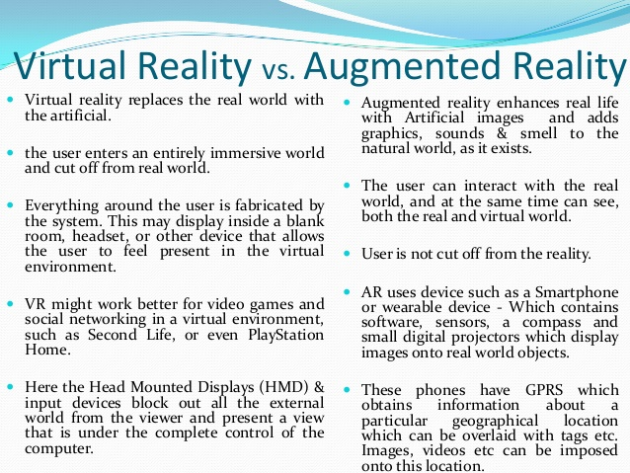The Difference Between Augmented Reality and Virtual Reality

With two of the most anticipated devices of this decade – Google Glass and the Oculus Rift – expected to hit shelves at some point in 2015, people are starting to hear the terms virtual reality (VR) and augmented reality (AR) more often. The simplest way to explain what these two terms mean, and to understand the difference between the two, is to look at the obvious functional and aesthetic differences between Google Glass (augmented reality) and the Oculus Rift (virtual reality).
Augmented Reality Explained
Google Glass is a headset that looks a lot like a pair of regular glasses, with only one subtle difference: the cyborg-like mini-screen perched in the top corner. This mini computer with an attached camera lets the user interact with the internet and installed apps while moving throughout the world, kind of like a smartphone perched in your glasses. Google Glass does not entirely block your view of reality, nor does it intend to create visuals that reach beyond the small corner screen.
To truly understand what augmented reality means, let's look closer at the term augmented, which is defined as – "having been made greater in size or value." In the case of Google Glass, the product augments reality by making it greater in value, not in size. Glass is intended to add value to reality by giving you quick access to the internet and a way to digitally interact with the surrounding world. For example, looking at a popular landmark while wearing Google Glass will augment the scenery with information about that particular spot, with pictures and links to useful resources and nearby attractions. Essentially, augmented reality devices are supposed to improve reality, rather than replace it.
Virtual Reality Explained
The Oculus Rift on the other hand represents the pinnacle of virtual reality, which is perhaps the closest concept to augmented reality, but very different in that it is much more intense and enveloping. Virtual reality immerses the wearer in an interactive experience by saturating their entire field of vision with precisely projected 3-dimensional HD visuals. Virtual reality intends to simulate a digital environment, mainly for the purposes of gaming, entertainment, communication, and virtual training. A pedestrian can't safely walk down the street while wearing an active virtual reality device, but they can safely do so while wearing an augmented reality device.
The tech industry has historically placed a lot more emphasis on virtual reality, with such devices being a hot topic of research throughout the modern gaming era. With virtual reality headsets being featured in a slew of sci-fi movies (such as Gamer with Gerard Butler), it is not surprising that consumers and manufacturers have been more interested in virtual reality lately. Plus, quite frankly, many people think that augmented reality doesn't seem as exciting as virtual reality. Facebook apparently recognized the value of virtual reality as a next generation tool, as the mega social network acquired Oculus VR for $2 billion in 2014.
Still, augmented reality is a field that is only recently starting to receive due attention with the advent of Google Glass and similar headsets. With that said, it's likely that in the near future augmented reality devices could find more applicable uses than virtual reality devices.
The quick comparison above should pretty much summarize the difference between augmented reality and virtual reality. As consumers start to see these devices in stores and in their communities more frequently, these terms and their definitions should become relatively common knowledge. In the meantime, the image below does a good job of expounding on AR vs. VR:

